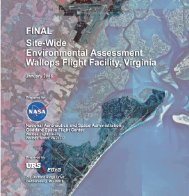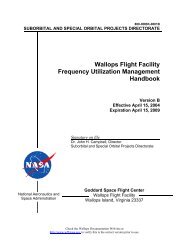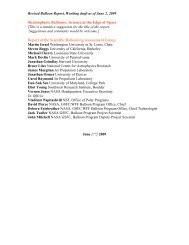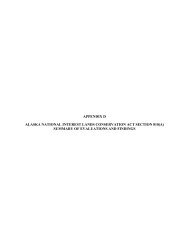Alternative Energy Draft EA - NASA Visitor Center at Wallops Flight ...
Alternative Energy Draft EA - NASA Visitor Center at Wallops Flight ...
Alternative Energy Draft EA - NASA Visitor Center at Wallops Flight ...
You also want an ePaper? Increase the reach of your titles
YUMPU automatically turns print PDFs into web optimized ePapers that Google loves.
3.1.4 Clim<strong>at</strong>e Change<br />
Table 8: Calendar Year 2008 Air Emissions <strong>at</strong> WFF<br />
Affected Environment<br />
Pollutant Emissions (metric tonnes per year/tons per year)<br />
CO 0.46 / 0.51<br />
NOX<br />
1.93 / 2.13<br />
SO2<br />
2.98 / 3.28<br />
VOC 0.05 / 0.06<br />
PM10<br />
0.20 / 0.22<br />
PM 0.18 / 0.20<br />
There is scientific evidence th<strong>at</strong> the chemical composition of the Earth’s <strong>at</strong>mosphere is being<br />
changed by human activities, such as fossil fuel combustion, deforest<strong>at</strong>ion, and other land use<br />
changes, resulting in the accumul<strong>at</strong>ion of trace GHGs in the <strong>at</strong>mosphere (<strong>NASA</strong>, 2010a). By<br />
absorbing the radi<strong>at</strong>ive energy from the sun and earth, GHGs trap he<strong>at</strong> in the <strong>at</strong>mosphere and<br />
such accumul<strong>at</strong>ion in the <strong>at</strong>mosphere may be contributing to an increase in the Earth’s average<br />
surface temper<strong>at</strong>ure, which in turn is expected to affect we<strong>at</strong>her p<strong>at</strong>terns and severity of<br />
storms/droughts, average sea levels, and increased intrusion of seaw<strong>at</strong>er into estuaries. Other<br />
effects are changes in precipit<strong>at</strong>ion r<strong>at</strong>es, an increase in O3 levels due in part to changes in<br />
<strong>at</strong>mospheric photochemistry, and decreased w<strong>at</strong>er availability and quality (Jones & Stokes,<br />
2007).<br />
GHGs include w<strong>at</strong>er vapor, CO2, methane (CH4), nitrous oxide (N2O), O3, and several hydroand<br />
chlorofluorocarbons. These emissions occur from both n<strong>at</strong>ural processes and human<br />
activities. W<strong>at</strong>er vapor occurs n<strong>at</strong>urally and accounts for the largest percentage of GHGs, and<br />
CO2 is the second-most abundant GHG. Some GHGs are directly emitted from human processes<br />
(CO2, chlorofluorocarbons, and w<strong>at</strong>er vapor), while other gases (e.g., NOX and VOCs) emitted<br />
from these processes contribute indirectly by forming tropospheric (ground-level) O3 and other<br />
reactive species. Those compounds then react with GHGs and control the amount of radi<strong>at</strong>ion<br />
penetr<strong>at</strong>ing through the troposphere.<br />
As GHGs are rel<strong>at</strong>ively stable in the <strong>at</strong>mosphere and are essentially uniformly mixed throughout<br />
the troposphere and str<strong>at</strong>osphere, the impact of GHG emissions on the clim<strong>at</strong>e does not depend<br />
upon the source loc<strong>at</strong>ion. Therefore, regional clim<strong>at</strong>e impacts are likely a function of global<br />
emissions.<br />
Each GHG is assigned a global warming potential (GWP), which is the ability to trap he<strong>at</strong>, and is<br />
standardized to CO2, which has a GWP value of one. For example, N2O has a GWP of 310,<br />
meaning it has a global warming effect 310 times gre<strong>at</strong>er than CO2 on an equal-mass basis. For<br />
simplific<strong>at</strong>ion, total GHG emissions are often expressed as a CO2 equivalent (CO2e). The CO2e is<br />
calcul<strong>at</strong>ed by multiplying each GHG emission by its GWP and adding the results to produce a<br />
combined r<strong>at</strong>e to represent all GHGs.<br />
There are a multitude of St<strong>at</strong>e and regional regul<strong>at</strong>ory programs requiring GHG emissions<br />
reductions. Although Virginia has no current GHG legisl<strong>at</strong>ion, the Governor issued Executive<br />
Order 59 in 2007, which established the “Governor’s Commission on Clim<strong>at</strong>e Change” (Bryant,<br />
2008). Since then, VDEQ cre<strong>at</strong>ed a Clim<strong>at</strong>e Change Steering Committee and GHG Emissions<br />
Workgroup who have focused on possible regional reduction targets, among other items. In<br />
44














